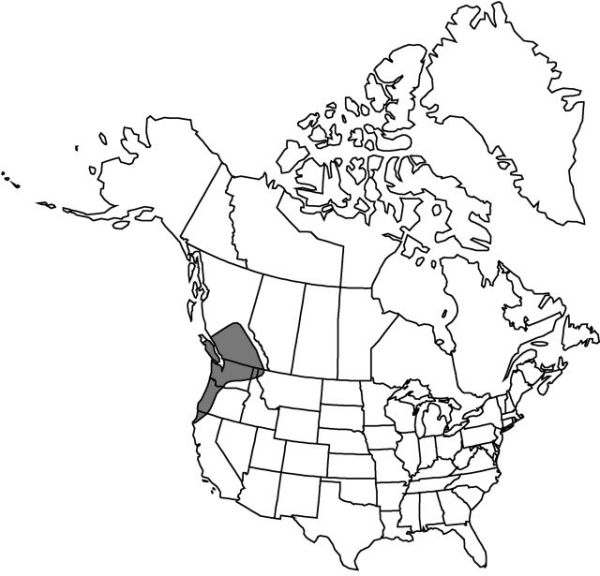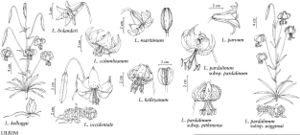Lilium columbianum
J. Soc. Centr. Hort. France, sér. 2, 5: 98. 1871.
Bulbs variable, subrhizomatous to ± ovoid, 3.1–8.1 × 3.6–10.6 cm, 0.3–1.4 times taller than long; scales 2–3(–5)-segmented, some unsegmented, longest 3.1–7.3 cm; stem roots absent. Stems to 1.7 m, glaucous or not. Buds rounded in cross section. Leaves in 1–9 whorls or partial whorls, 3–25 leaves per whorl, usually ascending, 1.7–15.7 × 0.4–4.7 cm, 2.4–7.4 times longer than wide; blade weakly oblanceolate to obovate or ± elliptic, margins usually somewhat undulate, apex acute; veins and margins ± smooth abaxially. Inflorescences racemose, 1–25(–45)-flowered. Flowers pendent to nodding, not fragrant; perianth Turk’s-cap-shaped; sepals and petals reflexed 2/5–1/2 along length from base, yellow or orange to occasionally red, with copious maroon spots, often darker and especially reddish abaxially, not distinctly clawed; sepals not ridged abaxially, appearing wide for their length, 3.4–7.1 × 0.8–1.9 cm; petals 3.5–6.9 × 0.8–1.9 cm; stamens barely to moderately exserted; filaments moderately spreading, diverging 10°–20° from axis; anthers pale yellow to yellow, 0.5–1.3 cm; pollen orange or yellow; pistil 2.4–3.7 cm; ovary 1.1–2.2 cm; style green; pedicel 2.8–20.2 cm. Capsules 2.2–5.4 × 1.1–2 cm, 1.7–3.3 times longer than wide. Seeds 135–330. 2n = 24.
Phenology: Flowering summer (early May–early Aug).
Habitat: Coastal scrub and prairies, meadows, conifer or mixed forests, clearings, roadsides
Elevation: 0–1800 m
Distribution

B.C., Calif., Idaho, Mont., Oreg., Wash.
Discussion
The author citations often seen for this species derive from Baker (1874), who published the name as Lilium columbianum “Hanson in hort., Leichtlin”; this authority is given by various later writers as Hanson, or Baker, or Hanson ex Baker. However, Ducharte’s (1871) recapitulation of a letter from M. Leichtlin is apparently the first confirmed and valid publication of L. columbianum, and hence that citation is used here.
This widespread lily is rather variable. In California plants the stamens are considerably less exserted than those of plants found farther north. Lilium columbianum may intergrade with L. kelloggii along Highway 199 at the border between California and Oregon; these plants are slightly fragrant, the stamens moderately exserted, and the bulb scales unsegmented. Lilium columbianum hybridizes with L. pardalinum subspp. wigginsii and vollmeri, and extensively with L. occidentale in Oregon.
Lilium columbianum is pollinated primarily by rufous hummingbirds [Selasphorus rufus (J. F. Gmelin), family Trochilidae] and to a lesser extent by large butterflies, including the pale swallowtail (Papilio eurymedon Lucas, family Papilionidae).
Native Americans used Lilium columbianum bulbs as a food or peppery condiment, sometimes mixed with meat or salmon roe. For many, it was a staple food (J. Pojar and A. MacKinnon 1994).
Selected References
None.
